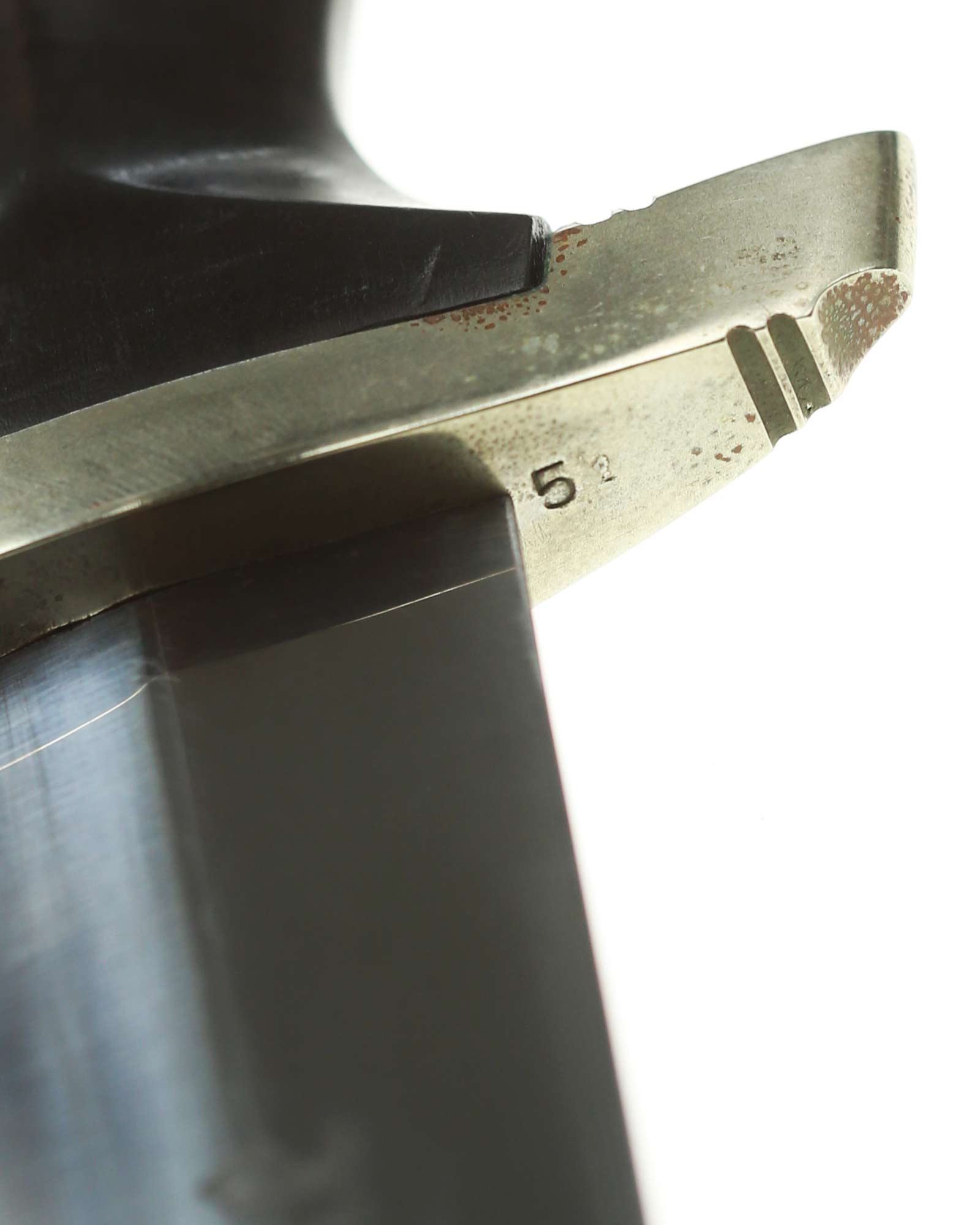Not Available!
Maker
Eickhorn Carl, Solingen
Model
1933-1935 [Early Model]
Inscription
Meine Ehre heißt Treue «My honor is loyalty»
Blade
double-edged
Length
375 mm
Weight
450 g
Hanger
Leather Hanger
Condition
EXC+
SS Dagger [Early Model] with Hanger by Carl Eickhorn Solingen
SS [Schutzstaffel] Dagger in early Version. Modell 1933. This early SS Dagger is with the Maker Carl Eickhorn Solingen. The dagger is in EXC+ condition throughout.
Grip: This grip fits the crossguards. There are some indications of wear on this grip. The runes displays good enamel, and the silvering to the runes and double-circled borders nicely match. The grip eagle is the early, “High Necked” variety. All the details are visible throughout the bird's feathering, talons, wreath, and mobile swastika. This early dagger is equipped with nickel crossguards and tang nut. These guards are in good shape. The guards are still in good condition, showing an average amount of wear from use.
Blade: The blade of this example is still in mint condition. The motto Meine Ehre heißt Treue «My honor is loyalty» is crisp and deep. The reverse ricasso of the blade is matching-etched formed by the firm's name and location, “Carl Eickhorn Solingen”. The blade shoulders perfectly meet the lower crossguard contour.
Scabbard: The matching nickel scabbard mounts are in excellent condition.

SS Dagger [Early Model] with Hanger by Carl Eickhorn Solingen
SS Dagger – Symbol of “Loyalty”
The SS dagger is more than just an edged weapon – it was an ideological and status-related emblem within the Schutzstaffel (SS). It embodied the SS motto “My honor is loyalty” and was awarded to members after their probation period as a sign of their loyalty and commitment.
History and Development
The introduction of the SS dagger dates back to the early 1930s when the SS evolved from a small guard unit into an independent organization. Starting from November 9, 1933, SS members were granted the right to wear the dagger as a visible symbol of their membership. Various production periods can be identified:
- Early period (1933–1935): High craftsmanship, nickel-silver fittings, deep etching of the motto, and fine blade finishing.
- Mid-period (1936–1938): RZM (Reichszeugmeisterei) control introduced, with initial simplifications in production.
- Late period (1939–1942): Simplified production, use of zinc and aluminum fittings, and less pronounced etchings
Grip
The grip was made of ebony and bore the silver SS emblem and the eagle with a swastika. Early models featured precise hand fitting, while later pieces were produced more economically
Crossguards
The crossguards were produced from nickel silver, nickel-plated zinc, or, in rare cases, aluminum. Early crossguards often carry Roman numerals (I, II, or III) indicating the production district, as well as internal maker’s marks such as "P&A" or "H&E". Over time, simplifications in finish became apparent, and many surviving examples show natural patina or plating loss
Blade and Motto
The blade was forged in Solingen and finely ground by hand. It bears the iconic motto “Meine Ehre heißt Treue” (“My honor is loyalty”), which was applied using stencil and acid etching. The style of the motto varied slightly depending on the manufacturer. Early daggers show deep, dark etching, while later models display shallower, less detailed inscriptions
Manufacturers
Prominent manufacturers include:
- Carl Eickhorn
- Robert Klaas
- Heinrich Böker
- Gottlieb Hammesfahr
- F. Herder
- along with many others identified by RZM license numbers
Scabbard
The scabbard was made of steel with a black lacquer finish and nickel-plated fittings. Early examples feature a glossy finish, while later versions use simpler matte coatings and zinc fittings. Many daggers were equipped with leather hangers for wear with the uniform.
Wearing the Dagger
The SS dagger was worn on the black SS uniform belt. It was primarily a symbol of status and ideology rather than a combat weapon, representing loyalty to the SS and Heinrich Himmler himself.
Special Variants
- Röhm Daggers (1933–1934): Early daggers with a dedication to SA leader Ernst Röhm. After the “Röhm Putsch,” most dedications were removed.
- Honor Daggers: Rare presentation daggers with special inscriptions or dedications, such as those from Heinrich Himmler.
0 Review(s)



![© DGDE GmbH - SS Dagger [Early Model] with Hanger by Carl Eickhorn Solingen © DGDE GmbH - SS Dagger [Early Model] with Hanger by Carl Eickhorn Solingen](https://www.dg.de/media/images/product/info2/ss-dienstdolch-dagger-carl-eickhorn-solingen-3757-1.jpg)



 Exclusive offers 10 € voucher when you sign up to our newsletter.
Exclusive offers 10 € voucher when you sign up to our newsletter.








